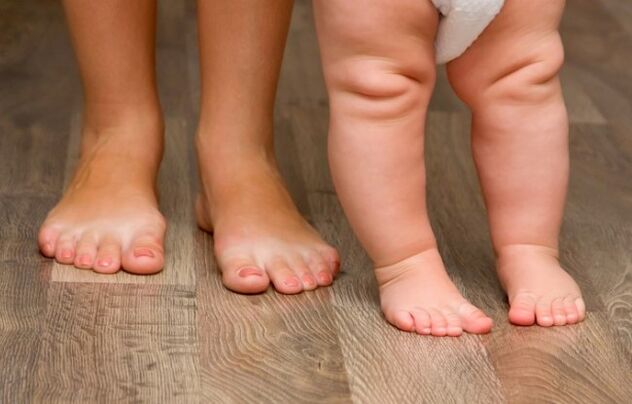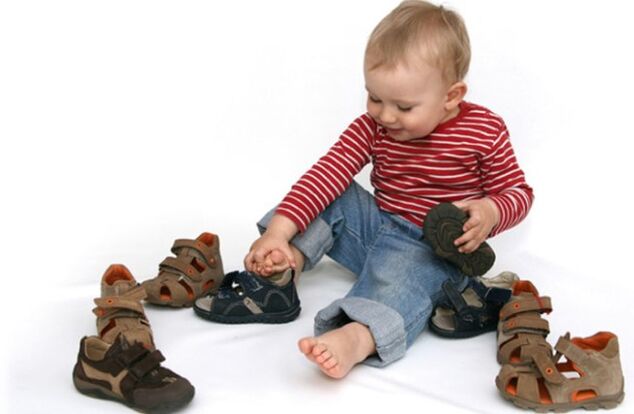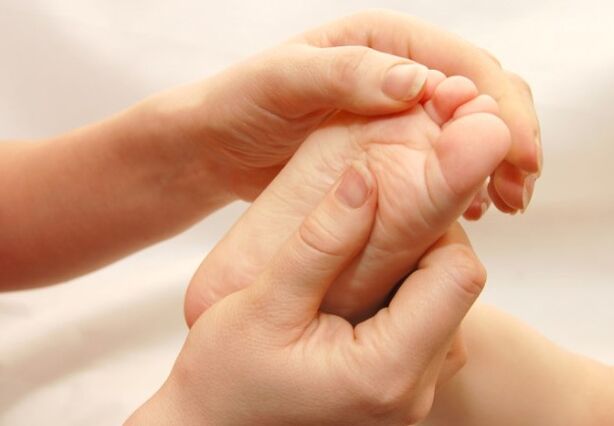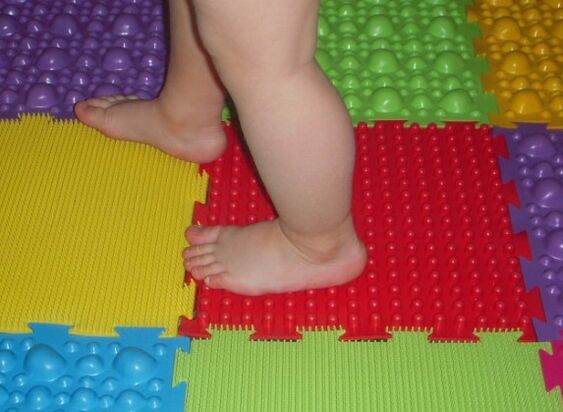The deformation of Valgus del Pieda in children takes place quite often in orthopedic practice: there are 100 healthy children with various degrees of feet dishes per 100 healthy.This diagnosis should not be frightened, it is necessary to understand the problem and start solving it under the guidance of an expert specialist.In most cases, the curvature of the feet is treated at home using operating therapy, massage and other auxiliary methods and surgery is required only in an advanced stage.

What is Valgus and Deformation Flat?
The valgus foot is a change in the axes of the lower limbs, in which the foot floods inside, and the heel region and the fingers are protruding outwards.With the timely diagnosis and implementation of all the doctor's recommendations, the defect is regulated and the correct set set is formed.The lack of treatment leads to a deformation of the flat value of the foot and a permanent change in the functioning of the musculoskeletal system.
Signs and symptoms of Valgus deformation in a child
The deformation of the foot in children is diagnosed for 1-1.5 years, when the child starts walking alone.In case of congenital pathology, the orthopedist will notice the deviation from the rule to 2-3 months of the child's life.
Parents can recognize the beginning of the disease itself, observing that the child mistakenly puts himself on the leg, moving the center of gravity inside.The pace can be observed clumsy, Kosolapih, pronounced plates.If you put the child directly and put the knees together, a distance of 4-5 centimeters is formed.With the development of deformation on both sides, the legs acquire the contours of the letter "x".There is a comparison between this pathology with "Kissing Knees" (see the photo).
The incorrect distribution of the load leads to the child's rapid effort, often prefers passive games, avoids physical activity.The older children often complain of pain in the lower part of the leg, joints and the spine, within the evening the swelling of the feet may appear.Gradually, the fingers and heels are deformed and differ, the skin on the feet thickens, the seeds appear.The shoes in a child with such deformation of the foot are torn in a non -uniform way: the interior of the sole is canceled faster.
Anatomical and functional dishes and their causes
All infants have anatomical plates, since the muscles, ligaments and tendons are constantly relaxed.When the child begins to get up and tries to walk, the binding apparatus is strengthened and the correct archery is formed.If this does not happen, the orthopedists speak of the development of functional dishes.
The reasons for the development of flat feet in small children:
- The consequences of the lack of calcium and other trace elements during pregnancy.A woman must follow all the advice of the doctor, adhere to a healthy lifestyle and eat well.
- Genetic factor.The pathology can be inherited, so if the flat feet are present in the parents, due attention should be paid to the prevention of deformation of the feet in the child.
- Rickets transferred.One of the causes of the pathological formation of the foot is the lack of vitamin D. The bones are softened, the musculoskeletal system is curved and the set of the foot is flattened.
- Initial setting on the legs.Although the child may like to rely on the legs, do not let him do before 7-8 months.
- The shoes selected incorrectly are too free or narrow on flat soles.Do not buy shoes for the child "for growth" (nutrition can be maximum of a size), since the foot will be in a free position.Walking barefoot on a flat surface (house on the floor).
- The following diseases can cause squamus of the installation of the feet: cerebral paralysis, polio, obesity, congenital dislocation of the thigh.Various lesions on the feet, long -term living room in plaster.

The degree of development of the pathology
There are four degrees of development of squamous curiosity:
- The first degree: the child turns his feet no more than 15 degrees.This is the initial phase of the deformation, with a serious approach to Valgus treatment, it can be well correct and the foot is completely straightened.
- The second stadium is characterized by a deviation of the foot of 15-20 degrees.For treatment, you will need a little more time and effort.
- With the third degree, the detour is 20-30 degrees.Prolonged treatment is required (the use of orthopedic shoes, massage, therapy for exercises, physiotherapy).
- The fourth is the most difficult curvature of the feet of over 30 degrees.In the absence of the effect of the complex treatment, the surgical correction of the lower limbs is performed.
Treatment methods
To obtain a persistent positive result, it is necessary to pay due attention to the treatment.It should be complex and long, after the appearance of the first results, in no case if you stop treating the child.The normal pace and the health of the child depend on the efforts and perseverance of the parents.Below are the main types of correction of the Valgus of the inferior extremities deformation.
Drug therapy
The medical drugs for the X -shaped curvature of the lower limbs are used to relieve inflammation and pain reliever of the joints, but it is impossible to get rid of the disease only with the help of drug therapy.Usually a specialist prescribes the intra -articular administration of drugs.
Orthopedic treatment with the use of devices and the choice of children's shoes
As prescribed by a doctor, to treat the curvature of the feet, it is possible to use special orthopedic devices: various physicians, bandages and tires.A prerequisite to obtain a persistent positive result is to wear orthopedic shoes.

When choosing such shoes, you need to pay attention to the following points:
- Shoes should be made with natural and respiratory materials;
- The child should feel comfortable with her, he shouldn't crush him anywhere;
- It is necessary to have a hard and tall ass so that the articulation and ankle heel are recorded in the correct position;
- the presence of fixing devices that regulate the shoes in the width of the foot;
- The presence of a small wide heel, ideally "thomas heel" (inside the foot it is slightly longer than from the outside).
Medical physical education and exercises for daily execution at home
The exercises must be performed daily, here are some:
- alternating walking on socks and walking on the heels (first with breed, then turned on the toes) for 5 minutes;
- Sitting on the floor with legs stretched to squeeze and unlock the fingers of the feet;
- You can offer the child to try to raise various small objects from the floor;
- Walking on an irregular surface, for example, can be brought home with the pebbles of the river or buy a massage carpet;
- walk on the outer edge of the foot;
- Know a wooden roller or ball;
- Rotation from the feet from left to right and vice versa.
Massage and physiotherapy
The massage is performed at home, courses for 2-3 weeks, then a break.This will contribute to strengthening the muscles and alleviating them from stress, so no special skills are needed.The total massage time is 20-30 minutes.You should start with a general massage: the child in a lying on the stomach, the hands are extended along the body, the head is turned on the side.Hand movements should not cause pain to the child:
- It is easy to caress the palms along the back, gradually increasing the pressure;
- Pat the witches with the edge of the palm, slightly pinch;
- resolve the folds of the skin in the direction of the rear part behind;
- Finish the rear massage by stroking;
- Stroaching the legs from the heels to the buttocks and back, is easy to pinch;
- Mark the legal legs and muscles;
- Finish to caress your legs.
- Rub the feet with the edge of the palm, gradually increasing the pressure;
- The thumb of the hand "draws" the number 7 on the sole;
- With one hand, keep your leg by the heel, the second - rub the ankle;
- It is easy to pull the leg for your fingers "on yourself".

If necessary, the doctor may prescribe physiotherapy, for example: magnetotherapy, acupuncture, electrophoresis, paraffin compresses.This will improve the metabolism in the problematic area and help obtain a complete absorption of drugs.
Surgery
In exceptional cases, when complex therapy does not give a result, parents are invited to surgically solve the problem.The modern methods used in surgery allow you to do without metal structures and wear plaster.The doctor corrects the direction of the ligaments and level the corner of the feet.After correction, they follow the recovery period and mandatory use of orthopedic shoes.
Is it possible to completely cure the deformation?
With a timely appeal to a specialist and a serious approach to treatment, Squamous is completely possible to straighten.At the same time, the treatment should be started until the age of two, so at school you can completely get rid of the curvature of the feet.In children over the age of 2 and with an advanced deformation of the lower ends, it is quite difficult to take care of the disorder until the end, but you can far improve the situation.
What can be the consequences if you don't take the curvature?
Squamous feet in children will not be corrected by themselves, so the symptoms of the pathology cannot be ignored.Such a deviation of the feet leads to a change in the entire musculoskeletal system.Due to the load distributed in a non -uniform way, there are problems with the joints of the knee and coxofemorale, as well as with the vertebral column.In the child, not only the booty of the pace, but also becoming impossible physical activity (running, active games), because this causes pain and inflammation in the joints.
- Starting from the newborn period, it is necessary to observe the development of the child's legs, inspect them for injuries, easily make massages and gymnastics.Promptly to undergo preventive exams at the Orthopedist and in his absence - to the surgeon.
- You shouldn't put the child too early on the legs - for the fragile muscles of the legs and joints, this is a huge load.When he hears the strength, he will try to get up, adheres to the support.For the same reason, the use of walkers and jumpers is undesirable, at least up to eight months.
- Particular attention should be paid to the pace: it should be correct and corresponding to age.With the slightest doubt, you should consult a specialist.
- Children's shoes should be of high quality, with a small heel and orthopedic slab (we advise you to read: children with dishes with flat feet).For seven months, when the child starts to stay on the legs, it is recommended to wear light sandals with a hard back, so the foot will be fixed in the correct position, the load on the muscles and joints will be distributed evenly.If there is a deformation of the 1-2 degree stop, it is advisable to buy orthopedic shoes in specialized shops and pharmacies.
- Rachion prevention.The child should spend enough time on the street, since vitamin D is formed in the skin under the influence of sunlight.For prevention, you can give the child vitamin D in a dosage prescribed by a doctor.It is necessary to provide a full and balanced diet.
- In summer, it is useful to give the child to run barefoot, small pebbles have a massage effect.At home, use a massage carpet with various irregularities every day for several minutes.
- Exercise strengthens the musculoskeletal system and prevents the development of flat feet.If possible, you can record a child for swimming or in the sports section (we advise you to read: how is the babies in the bathroom or in the pool?).

























